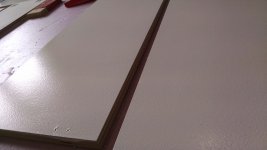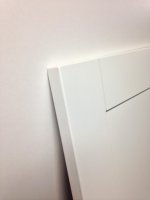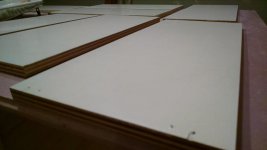Hi all,
My first post here. I'm the proud new owner of a TS-55 and an extra 55" rail (excellence.. especially the dust collection). For my first project using Festool, I am building some built-ins using Maple ply. I'm at the phase where I'm trying to get some pre-finishing done before I install, and I'm running into some issues.
Here's my schedule:
Primer - Zinsser Primecoat 2
Prime 1x
Sand @ 220
Prime 2x
Sand @ 320
Paint - BM Advance in Satin
I'm rolling everything with a whizz velour roller cover. I think it works out to something like 3/16". It's an indoor environment - about 68 degrees and relatively low humidity.
I put down the first coat of Advance today and I was very disappointed in the outcome. It has a bumpy orange peel texture - more texture than Regal or Aura have given me on other things I've done with thicker nap rollers.
Here is what I'm referring to:
[attachimg=1]
Anyone have any suggestions? Spraying is not an option here. I've read some folks suggest a tack-coat, and I could try rolling and tipping, but my expectation was that Advance leveled really well and that the velour cover would leave a pretty smooth finish. I'm not looking forward to sanding this down.
Thanks,
Adam
My first post here. I'm the proud new owner of a TS-55 and an extra 55" rail (excellence.. especially the dust collection). For my first project using Festool, I am building some built-ins using Maple ply. I'm at the phase where I'm trying to get some pre-finishing done before I install, and I'm running into some issues.
Here's my schedule:
Primer - Zinsser Primecoat 2
Prime 1x
Sand @ 220
Prime 2x
Sand @ 320
Paint - BM Advance in Satin
I'm rolling everything with a whizz velour roller cover. I think it works out to something like 3/16". It's an indoor environment - about 68 degrees and relatively low humidity.
I put down the first coat of Advance today and I was very disappointed in the outcome. It has a bumpy orange peel texture - more texture than Regal or Aura have given me on other things I've done with thicker nap rollers.
Here is what I'm referring to:
[attachimg=1]
Anyone have any suggestions? Spraying is not an option here. I've read some folks suggest a tack-coat, and I could try rolling and tipping, but my expectation was that Advance leveled really well and that the velour cover would leave a pretty smooth finish. I'm not looking forward to sanding this down.
Thanks,
Adam



